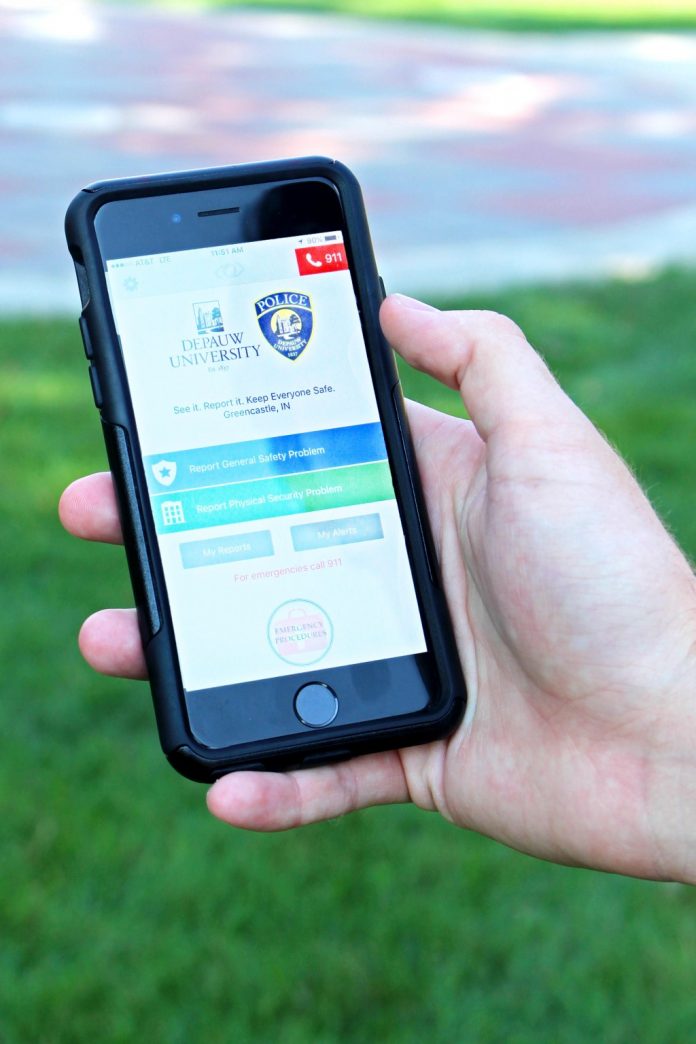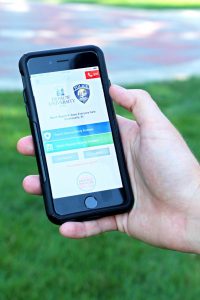

SAM CARAVANA / THE DEPAUW
Public Safety’s job just got a little bit easier with the release of Campus Eye, an application that creates a direct line of communication across your entire school—put in the palm of every students’ hands.
Campus Eye puts security and responsibility in the hands of students by providing users with the tools necessary to report what they see, hear, and know to public safety as soon as it happens. Through a simple, open form interface, students can report criminal acts ranging from vandalism to sexual assault, anonymously, in order to avoid unsafe behaviors and dangerous issues.
The DePauw spoke with alumnus Garrett Foley ‘15, and Vice President of Sales at Campus Eye about the development of the application as well as the timeline for launching the application on DePauw’s campus.
Being a former DePauw student, Foley “recognized that there were voids in DePauw’s security and student peers could be crucial to developing a safe network for others.” He presented Director of Public Safety, Angela Nally, with Campus Eye as a safety solution in November of 2015.
Nally recalled the original pitch and said, “Many of DePauw’s students have left DePauw and started working at different companies and we are their logical first choice to sell a product and I’ve never been one to engage in these different products, but Garrett (Foley) was the first time I thought that this could be really useful.”
In addition to Foley’s cooperation, Kya Simons ‘16, was instrumental in helping Public Safety understand and diagnose the problems with other solutions the department was vetting.
“I asked her (Simons) for a student perspective and asked her which one would be the most useful for her peer group. She looked at these products and narrow this down into something manageable,” said Nally, “After multiple demonstrations and prioritizing features for both students and public safety officers.”
Simons’ role in the Public Safety office was to analyze an appropriate modern way for students to respond to their safety concerns.
Prior to Campus Eyes’ launch at DePauw, the application had gone through beta testing and used to its full capacity on multiple campuses in Campus Eyes’ home state of Missouri.
Schools such as the University of Missouri – Kansas City and University of Central Mississippi have both seen an increase in the number of incidents reported both in facility management and campus criminal activity. The testing at these schools, ranging from 14,000 – 16,000 students, demonstrated Campus Eye’s ability to accommodate for a campus both small and large.
The application’s simplicity is its strength. After signing in, users are introduced to a simple interface that gives them three options: “Report General Safety Problem,” “Report Physical Security Problem,” or if in immediate distress, call 911 directly.
After an option is selected, users are taken to a page where they can immediately text their concern or report. A simple swipe tab will allow the user to make their account anonymous in addition to being able to attach images from their phone’s camera roll onto the report. In real time, an officer can respond to the report and have a conversation if details necessary to security are missing.
“At first I thought students might need more structure. But because we can respond to users it makes it easy to engage in communication with students who need assistance,” Nally said.
When asked about whether this open ended response form may lead to deviant behavior, Nally responded, “I don’t see our students using it maliciously. Its for their own safety and we are trying to be up to date about how it’s easiest for our students to respond to you”.
When Foley was asked about the same potential deviance, he emphasized their positive results “from our experiences we’ve only seen the benefits. Safety and security”.
Nally hopes that Campus Eye will successfully replace inundated and ineffective previous safety response programs such as Silent Witness. In the past, Silent Witness has become ineffective in its means of reporting crime as the interface did not cater to the sense of immediacy necessary to combat urgent crimes as well as a low number of reports in recent semesters.
In addition to replacing previous systems, Nally believes it works hand in hand with different advocacy groups, promoting “DePauw’s existing safety narrative, that we should all be positive bystanders and the kind of open form format of the application allows for specific reports that can empower our officers and our students.”
Student advocacy groups are the ones who have helped contribute to this growing narrative of positive intervention and groups like Green Dot hope that this application can go hand in hand with their objectives.
Student Coordinator for DePauw Green Dot, senior Cate Hensley, commented how Campus Eye can lead to sexual assault prevention and said, “The only evidence based intervention that decreases the instances of power based personal violence is bystander intervention,” she continued, “Hopefully this can lead to further campus climate discussion, and interest in Green Dot bystander intervention training.”
Campus Eye’s goal is to empower students to report suspicious activity no matter the size. From small maintenance issues to reporting sexual assault, DePauw’s incorporation of Campus Eye puts the power in the palms of students to positively impact their campus.
